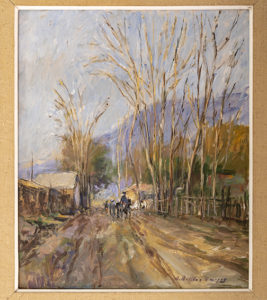 I received an overwhelming response to my article “How to Judge a Thrift Store Painting.” One reader asked if I owned an ‘orphan’ painting in my home. She wants me to evaluate it for her, trace the course of WHY I spent the $22 to purchase the work. In the photo you see the corner of my house where the painting lives with other orphans, then below a close up of the painting which I will analyze here.
I received an overwhelming response to my article “How to Judge a Thrift Store Painting.” One reader asked if I owned an ‘orphan’ painting in my home. She wants me to evaluate it for her, trace the course of WHY I spent the $22 to purchase the work. In the photo you see the corner of my house where the painting lives with other orphans, then below a close up of the painting which I will analyze here.
I hope my exploration of this painting helps you go beyond “I like it!” The objective is to determine WHY you like it.
The first rule, using my orphan painting as an example, is “intention.” Did the artist, within a certain genre (style) fulfill their intention? Has the artist endeavored successfully to paint a rural country road, in a realistic, yet evocative, “free” or “impressionistic” style? The artist did this well, within an accepted standard of a certain genre. They intended to evoke a mood, an atmosphere, down to the crispness of the weather, the suggestion of movement of the horse and cart.
Next, look at the brushstrokes.
 Is the artist skilled? Do they know how to move a brush and use the paint? In my painting, I see that the artist DOES. Look at the detail of the horse and rider. The artist painted a few lines that imply both motion and the figures themselves, which takes skill and practice.
Is the artist skilled? Do they know how to move a brush and use the paint? In my painting, I see that the artist DOES. Look at the detail of the horse and rider. The artist painted a few lines that imply both motion and the figures themselves, which takes skill and practice.
Now we turn to ‘meaning’ – the content or narrative of the piece. Again, this is an element that ‘fits’ within a style. Certain genres of painting must involve a narrative, such as history paintings or mythological (called academic) paintings, and realist scenes, such as a domestic interior. The meaning resides in the STORY. In my orphan painting I find the meaning in the lonely cart and rider on the wild road. Where is he going? What does he carry? Is he lonely or traveling to a friend?
Concept
Other styles of paintings do NOT involve a story, but all paintings involve a CONCEPT. The concept, for example, in abstract painting is the painting itself. A painting does not HAVE to be ‘about’ anything. Ask: did the artist CONVEY the concept of the painting well? Color has a lot to do with this question, because each color tends to evoke a mood, especially when artfully painted with opposing color or repeated color. In the case of my orphan painting the violet blue and the contrast yellow ochre are used to convey the landscape to a fine effect.
Along with color, notice texture
 Did the artist lay the paint on thinly, or in an architectural technique called ‘impasto?’ Texture plays a part in the narrative. In this case the trees are painted with a thicker line, and seem to loom over the horse and cart, emphasizing the loneliness of the figures.
Did the artist lay the paint on thinly, or in an architectural technique called ‘impasto?’ Texture plays a part in the narrative. In this case the trees are painted with a thicker line, and seem to loom over the horse and cart, emphasizing the loneliness of the figures.
Next, did the artist use the space he chose, or is the space too big, losing the message? Too small or the wrong shape? In this case the size appears good (spacious) and the shape (vertical) feels appropriate to the emphasis on the height of the trees.
This brings us to proportion.
Do the horse and cart seem unrealistically small? Does it “read” in the size the artist painted it in? The smallness of the main subject of the painting works for me. The artist set the figure back into the picture plane to emphasize the engulfing feeling of the trees.
The final arbiter of quality applies to the sense of a unique vision offered by the artist. Have you seen this a million times before? To achieve a level of connoisseurship you must have seen a few GOOD and GREAT paintings in order to sense uniqueness. If you don’t sense a singular vision the piece can appear banal and boring. Your eye will not want to stay in the canvas to find other levels of interest, such as repeated shapes, or perhaps a triangular or circular composition, that keeps the eye involved. If the piece has nothing unique to say, you’ll soon lose interest. In the case of my orphan the color keeps me involved, but NOT the uniqueness of the vision. I don’t see much originality in this piece. I regard it as a ‘nice’ painting that most could ‘live’ with. The artist painted it for visual appeal with little depth to its vision.